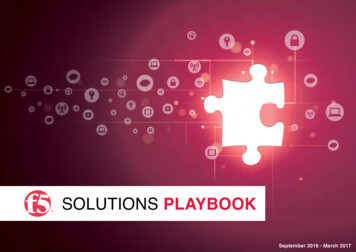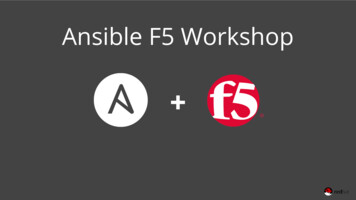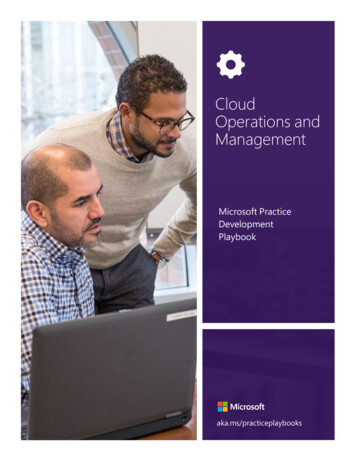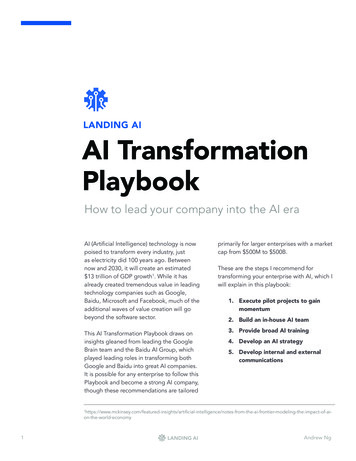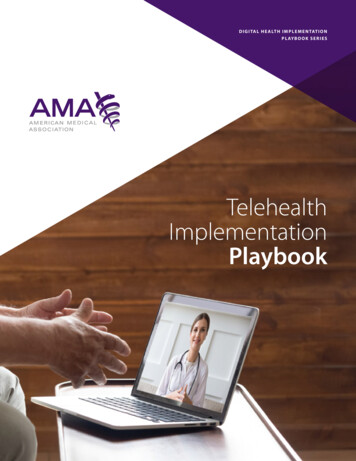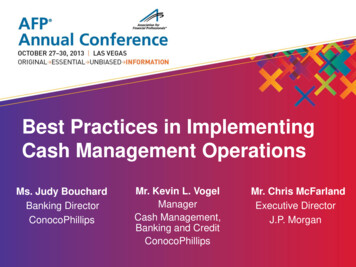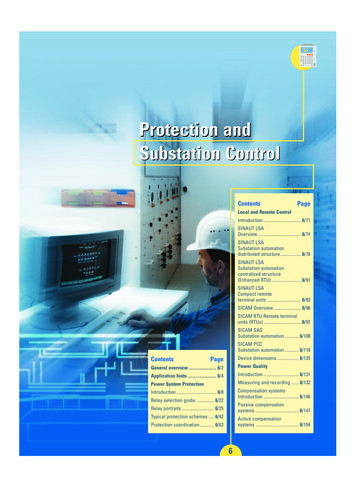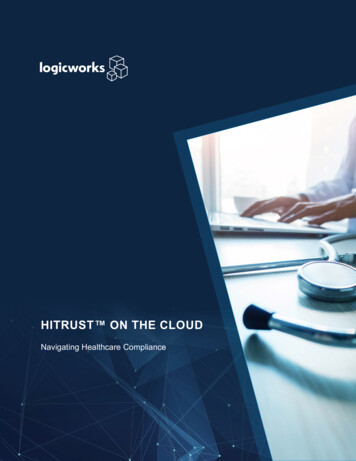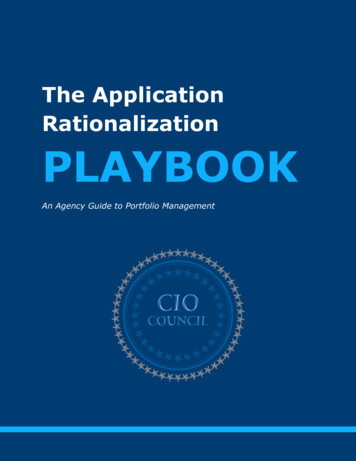
Transcription
The ApplicationRationalizationPLAYBOOKAn Agency Guide to Portfolio Management
Table of ContentsTable of Contents1Introduction to Version 1.13Introduction to the Playbook3Key Terms4Disclaimer4A Six-Step Process for Application Rationalization5Step 1: Identify Needs and Conduct Readiness Assessment71.1 Conduct Readiness Assessment71.2 Identify Requirements81.3 Develop a Questionnaire8Step 2: Inventory Applications102.1 Send Questionnaire102.2 Validate Responses102.3 Create Application Onboarding Process10Step 3: Assess Business Value and Technical Fit113.1 Review Business Value and Technical Fit Responses113.2 Determine Application Dependencies113.3 Identify Application Duplication11Step 4: Assess Total Cost of Ownership124.1 Determine Current-State TCO124.2 Identify Cost Outliers13Step 5: Score Applications155.1 Develop a Consistent Scoring Methodology155.2 Review Application Scores155.3 Engage Program Offices for Transparency and Feedback15Step 6: Determine Application Placement176.1 Group Applications Based on Application ScoresApplication Rationalization Playbook17Page 1
6.2 Assess Future-State TCO and Hosting Options186.3 Analyze Hosting Alternatives for On-Premise Applications186.4 Develop Migration Strategy and Change Management Plan20Conclusion23Appendix24Appendix 1 - Example Inventory Sources24Appendix 2 - Policies and Guidelines24Appendix 3 - Business Value Sample Questions26Appendix 4 - Technical Fit Sample Questions28Appendix 5 - The Application Rationalization Data Dictionary29Application Rationalization PlaybookPage 2
Introduction to Version 1.1The Application Rationalization Playbook is designed to be an iterative document thatevolves over time to reflect agency learning and a changing federal information technology(IT) landscape. Since the Playbook’s original release, many agencies have kicked-off theirown application rationalization efforts, stress-tested the plays at their agencies, andprovided ample feedback and suggestions to improve the Playbook. This updated versionincorporates feedback and input based on agency experience, sharpens and clarifiesconcepts, and removes redundant or unnecessary language. Specifically, there is addedfocus on the principles of Organizational Change Management (OCM), new agency casestudies and lessons learned, and updates based on new Office of Management and Budget(OMB) policy and Administration guidance. It also includes information on the ApplicationRationalization Data Dictionary, which aims to help agencies strategically and systematicallyidentify business applications and determine which should be kept, replaced, retired, orconsolidated.Introduction to the PlaybookThis playbook is a practical guide for application rationalization and IT portfoliomanagement. Application rationalization is the effort to strategically identify businessapplications across an organization to determine which should be kept, replaced, retired, orconsolidated. This includes developing a detailed inventory, with attributes and functionality,determining business value and total cost of ownership (TCO), and then comparing orrationalizing that inventory of applications as a whole to eliminate redundancies, lowercosts, and maximize efficiency. Application rationalization helps Portfolio Managers improvetheir agency’s approach to IT modernization. There is no one-size-fits-all applicationrationalization process, rather agencies should tailor their approach to fit mission, business,technology, human capital, and security needs.Application rationalization drives improved IT portfolio management capabilities, empowersleaders to make better decisions, and enhances the delivery of key mission and businessservices. Successful application rationalization efforts require buy-in from criticalstakeholders across the enterprise, including senior leaders, IT staff, cybersecurity experts,mission and program owners, financial practitioners, acquisition and procurement experts,and end user communities. Rationalization efforts rely on leadership support and continualengagement with stakeholders to deliver sustainable change. This playbook providessimplified steps that break application rationalization down into component parts and itaddresses challenges and opportunities for IT leaders approaching application rationalizationfor the first time.This playbook is designed to be iterative, and agencies are encouraged to collaborate andshare best practices and lessons learned from their own application rationalizationexperiences. For more information, please join the Cloud and Infrastructure Community ofPractice (C&I CoP). To learn and engage with C&I CoP, please email the Data Center andCloud Optimization Initiative (DCCOI) Program Management Office (PMO) at dccoi@gsa.govwith your request to join.Application Rationalization PlaybookPage 3
Key TermsDefinitions of key terms used throughout this document. Application - A software program used directly or indirectly to support the programoffice in delivering on a business or mission function; includes mobile applicationsApplication owner - The individual or group within the program office that directlyoversees an applicationBusiness value - Qualitative and quantitative measures of an application’s valueComponent - A discrete unit within a federal agency, such as a bureau ordepartmentEnterprise - An entire agency, including program offices and componentsPortfolio Manager - The individual or office responsible for executing applicationrationalization for the entire organization 1Program office - The office or organization within the agency that owns or operatesan application that delivers a business or mission functionTechnical fit - A measure of an application’s technological healthDisclaimerThis playbook was developed by the Chief Information Officer (CIO) Council and the Cloud &Infrastructure Community of Practice (C&I CoP), with input from key federal IT practitionersand industry representatives. This document does not provide authoritative definitions of ITterms and should not be interpreted as official policy or mandated action. Rather, thisplaybook supplements existing federal IT statutes and policies, and builds upon the keycomponents of the Cloud Smart2 strategy.1Per FITARA and EO 13833, the CIO must be involved in ”all management, governance, and oversight processesrelated to IT.” At some agencies, portfolio managers are senior members of the Office of the Chief InformationOfficer (OCIO), such as the chief enterprise architect, while other agencies identify other stakeholders to lead theirapplication rationalization efforts. While agencies are free to include other stakeholders, the CIO, or a designee,must be included in the process.2See https://cloud.cio.gov/.Application Rationalization PlaybookPage 4
A Six-Step Process for Application RationalizationThe six-step process outlined below is a structured, iterative approach to applicationrationalization for IT Portfolio Managers. The six steps provide discrete actions foragencies to consider when undergoing application rationalization. Agencies are encouragedto tailor these steps to meet organizational structures, unique requirements, and missionneeds.Step 1: Identify needs and conduct readiness assessment.Work with critical stakeholders, such as the agency OCIO, to conduct an applicationrationalization readiness assessment, develop the application questionnaire, and create abaseline inventory.Step 2: Inventory applications.Conduct an Environmental Scan to identify applications not in the Baseline Inventory andsend the Questionnaire to the stakeholders to capture relevant data pertaining to eachapplication.Step 3: Assess the business value and technical fitFor each application in the application inventory, analyze and validate business value andtechnical fit data captured in the Questionnaire. Engage program offices ensure data quality.Review the application inventory to identify dependencies and duplication.Step 4: Assess the total cost of ownership (TCO)Assess each application’s TCO captured in the Questionnaire. Compare TCO in the currentstate against estimated TCO in future-state architectures.Step 5: Score applicationsBased on the business value, technical fit, and TCO, score all applications and determinewhether each should be reviewed, rewarded, removed, or refreshed.Step 6: Determine application placementBased on the application scores, develop and execute a change management andapplication migration strategy for future iterations.Application Rationalization PlaybookPage 5
Figure 1: Application Rationalization Six-Step ProcessFigure 1 shows application rationalization as an ongoing best practice for good IT portfoliomanagement. The speed of technological change means there is constant investment in newapplications, decommissioning legacy IT, and refactoring applications to reflect changingtechnology and business environments. Agencies must routinely update and rationalize theirportfolios to enable IT managers to make informed business decisions. Applicationrationalization uncovers issues such as application duplication, siloed business units, andunnecessary IT costs, so agencies can address them head-on.Application Rationalization PlaybookPage 6
Step 1: Identify Needs and Conduct ReadinessAssessmentDetermine the scope and set governance for the application rationalization effort, thendevelop a standardized questionnaire and templates for all resources shared with programoffices during the application rationalization effort.1.1Conduct Readiness AssessmentBefore jumping into application rationalization, agencies should complete an applicationrationalization readiness assessment.Link to Application Rationalization Readiness Assessment ToolkitThis Readiness Toolkit leverages organizational change management (OCM) best practicesand provides templates to make the readiness assessment easy and straightforward. Aspart of this readiness assessment, agencies should assign an accountable portfolio manager,set up the application rationalization team (team) responsible for application rationalizationand IT portfolio management in the future, establish a business case for applicationrationalization, engage OCIO and executive leaders from across the enterprise to ensurebuy in for the effort, and conduct an environmental scan of existing application inventoriesusing automated discovery tools or existing inventories as a baseline application inventoryto start from. A good place to start when developing the baseline application inventory iswith the agency's Disaster Recovery and Continuity of Operations Plans (DR/COOP), whichmust take into account contingency planning and backups for critical applications andservices. An example of existing inventories can be found in Appendix 1.OMB Software License Management PolicyOMB policy M-16-12: Improving the Acquisition and Management of Common InformationTechnology: Software Licensing3 requires agencies to appoint a software managerresponsible for managing agency-wide commercial and commercial off-the-shelf (COTS)software service agreements and licenses. Furthermore, M-16-12 specifically mentionsSoftware Asset Management (SAM) tools, Software License Optimization (SLO) tools,Continuous Diagnostics and Mitigation (CDM) tools, Continuous Monitoring as a Service(CMaaS), network management tools, and finance and accounting systems to report onsoftware inventory, prices, and usage. Many agencies already have mature softwarelicense management practices and inventories in place. Application rationalization canleverage this work as a starting place when building the baseline application inventory.3OMB Memo for M-16-12 for Category Management Policy 16-1 Improving the Acquisition and Management ofCommon Information Technology- Software Licensing. https://hallways.cap.gsa.gov/app/#/doclib?document 8496Application Rationalization PlaybookPage 7
1.2Identify RequirementsEnsure the application rationalization effort aligns to current legislation, agency missionpriorities, relevant OMB policies (e.g., CPIC budget guidance, Software CategoryManagement), and other agency initiatives. See Appendix 2 for a list of relevantgovernment-wide legislation and policy. Additionally, determine the scope of the applicationrationalization effort in this step of the process. Many agencies, especially large, federatedagencies, choose to down-select their initial application inventory to a component orsubcomponents to more easily manage and refine the application rationalization process.1.3Develop a QuestionnaireDevelop a questionnaire that will be sent to each application owner in Step 2 of theapplication rationalization process. The questionnaire is the primary data collection tool thatwill be used to compare applications across the enterprise. The questionnaire should, atminimum, capture business value, technical fit, and total cost of ownership (TCO) for eachapplication. The questionnaire should also provide clear instructions to ensure uniformcompletion by respondents.Questions related to business value should assess the following factors for each application(See Appendix 3 for additional Business Value question examples): Effectiveness - the extent to which an application is a solution for the goal agenciesare trying to achieve;Mission criticality - the degree to which an application is critical in supporting andexecuting the agencies’ mission;Utilization - usage data for the application. Inventory tools can help agenciesmeasure usage without relying solely on requirement information provided by anapplication owner;Complexity - the customization, unique features and functions enabled by theapplication. Applications with greater complexity typically require unique skills todevelop and maintain, satisfy more technically difficult requirements, or pull frommultiple data sources; andUsability - how easy it is for the user or customer to operate or learn. 4Questions related to technical fit should assess the following factors for each application(See Appendix 4 for additional Technical Fit question examples): 4Technical requirements - what levels of storage, bandwidth, data, maintenance,and support are needed to make an application run;Software and hardware version control - how often is an application updatedand how much marginal effort does each update require from administrators andFor information on usability, use the system usability scale to measure customer experience. thods/system-usability-scale.html for more information.Application Rationalization PlaybookPage 8
users;Dependencies and interoperability - to what degree do other applications orsystems depend on this application to run, and what disruptions in other applicationswould affect it;Scalability and adaptability - can an application be scaled to onboard new usersand can it be augmented to fit the needs of new user groups; andSecurity standards - is an application vulnerable to security attacks and does it fitinto agency risk tolerance models.Application Rationalization PlaybookPage 9
Step 2: Inventory ApplicationsIn Step 1 of the application rationalization process, agencies conduct a readinessassessment, develop a questionnaire that teases out relevant application information, andcreate a baseline application inventory. In Step 2 of the process, agencies deploy thequestionnaire to application owners and program offices to collect relevant information oneach in-scope application.2.1Send QuestionnaireSend the questionnaire to application owners or program offices for each in-scopeapplication. This ensures uniform and reliable data collection, allowing the team to compareacross applications.2.2Validate ResponsesReview Questionnaire responses for completion and accuracy, then compare them withexisting inventory sources. Follow up with the application owner or program offices if thereare discrepancies between the responses provided on the questionnaire and informationfrom existing inventory sources. The team now has an authoritative application inventory.2.3Create Application Onboarding ProcessWork with the relevant stakeholders within the OCIO and other program offices to ensurenew applications and services are added to the authoritative application inventory goingforward. This ensures the application inventory is continuously updated and provides valuein the future. Application rationalization is not a one-time exercise but should become partof normal business operations within the agency.Application Rationalization PlaybookPage 10
Step 3: Assess Business Value and Technical FitIn Step 2 of the application rationalization process, agencies inventory applications bysending the questionnaire to each application owner and program manager, validate thoseresponses, and develop a process for maintaining the application inventory in the future. InStep 3, compile the responses to the questionnaire and assess the business value andtechnical fit for each application relative to all the applications in the inventory.3.1Review Business Value and Technical Fit ResponsesThe questionnaire developed in Step 1 should, at minimum, collect information related tothe business value and technical fit of each application. Often legacy applications are usedpast their support horizons, which increases operating costs and the risk of securityvulnerability. Weigh the business value and technical fit responses based on uniquebusiness and mission needs. For example, an application’s ability to perform core missionservices, such as a legislative mandate, administration priority, or leadership objective, isoften the most important factor when assessing business value and technical fit. There is noone-size-fits all application assessment methodology.3.2Determine Application DependenciesThe questionnaire should determine dependencies for each application in the inventory.Identifying upstream and downstream dependencies is critical for application rationalizationbecause applications with many dependencies are often more challenging and costly torefactor, migrate, or decommission. Many systems and applications share code, databases,and functionality. Applications with many dependencies tend to have higher business valueand applications. Although there are several commercial tools available to identifyapplication dependencies, not all dependencies are easily discoverable with automated tools.Some dependencies, such as applications for training users or knowledge dependenciescannot be readily mapped with automated tools. Therefore, the questionnaire should still beused to validate dependencies in the application inventory.3.3Identify Application DuplicationReview the application inventory for duplication. If components are using differentapplications to perform similar, standardized software functions, there is likely a goodbusiness case for an enterprise solution or intra-agency shared service. It’s common forcomponents to be uncoordinated when purchasing applications, which leads to redundantpurchases.Application Rationalization PlaybookPage 11
Step 4: Assess Total Cost of OwnershipIn Step 3 of the application rationalization process, agencies assess the business value andtechnical fit of each application. Step 4 of the process builds off Step 3 and looks at eachapplication’s total cost of ownership (TCO). Often agencies cite TCO as the most challengingpart of application rationalization because there are often hidden or unknown costs. In thisstep of the process, agencies will assess TCO information from the questionnaire, identifycost outliers in the inventory, and provide IT investment recommendations based on agencypriorities and current spend.4.1Determine Current-State TCOThe questionnaire provides TCO information for each application in the inventory. Often,agencies struggle to determine the exact cost of ownership for each application because ofhidden costs, considerations around projected future costs, depreciated value, how toaccurately account for cost savings and avoidances, convoluted service level agreements(SLAs) and terms of service, and other unknown costs.This playbook suggests agencies simplify the complex process of determining to the pennythe total cost of ownership for each application. Rather, the questionnaire sent toapplication owners and program offices in Step 2 should prompt respondents to provide costestimates for their applications within given ranges. The precise cost of ownership is lessimportant than the approximation of that cost with the added context of the application’sbusiness value and technical fit all relative to the agency's mission and business priorities.Technology Business Management (TBM) helps address some of the issues in accounting forIT costs. TBM is a great place to start when trying to understand all the costs associatedwith hosting, securing, and providing service to existing applications. However, there maybe non-IT costs that aren’t accounted for in TBM, such as costs associated with retraining orreskilling the agency’s workforce to use new tools and applications. To learn more aboutimplementing TBM at your agency, please refer to the TBM Playbook found on gsa.gov. 55https://tech.gsa.gov/playbooks/tbm/Application Rationalization PlaybookPage 12
Figure 2: The TBM Taxonomy4.2Identify Cost OutliersWork with application owners and program offices to ensure the most accurate andcomplete current-state TCO information is captured in the questionnaire, especially in theevent that outliers are identified, such as COTS business applications that far outpace thecost per user compared to similar projects on the market and within the agency. Costoutliers that don’t have corresponding high business value or technical fit are goodcandidates for review.Case Study: DOJ Application Rationalization ExperienceIn 2019, the U.S. Department of Justice (DOJ) used this playbook to pilot applicationrationalization at their agency. Of the DOJ’s 26 components, DOJ selected the AntitrustDivision (ATR) to conduct the pilot and to provide the rest of the Department with lessonslearned and a roadmap for full-scale application rationalization across the DOJ. DOJshared those lessons with the Cloud and Infrastructure Community of Practice and someof the lessons are included below. Overall, agencies are encouraged to tailor process stepscontained in this playbook to meet their individual agency’s needs. DOJ and ATR providedthe following lessons learned around how ATR adapted the playbook to meet ATR’sspecific application rationalization needs:1. Define what applications are included in the inventory collection. A formalizeddefinition should be documented and provided to all components participating inthe application rationalization efforts to ensure all components and stakeholdersApplication Rationalization PlaybookPage 13
are in agreement with the scope applications in play. Furthermore, each questionin the questionnaire should have specific definitions and directions to ensure, tothe greatest extent possible, that applications are being assessed and consideredusing the same methodology.2. Streamline questions related to total cost of ownership (TCO) for simplicity andcreate a standardized algorithm for calculated TCO to eliminate subjectivity andguesswork across components and programs. ATR determined that, as currentlyoutlined, determining TCO for each application is prohibitively time consuming.3. Tailor questions related to Business Value to meet agency specific needs. For ATR,most end users are litigating attorneys who did not have availability to participatein this effort. This made it difficult to accurately determine the Business Value foreach application as the questionnaire is currently written.4. Include a question for applications that are hosted in a physical, on-premiseenvironment to determine whether they are eligible, or have been previouslyconsidered, for migration to the cloud. ATR suggested this was a relevant datapoint to determine the most appropriate future-state hosting environment for theirapplications.5. ATR estimated the level-of-effort (LOE) to distribute and collect responses for the148 applications in their inventory to be about 200 hours total. This numberreflects ATR’s decision not to request the TCO for each application because, ATRdetermined, this activity would be prohibitively time consuming.6. ATR recommended that inventory collection and analysis should occur in aniterative manner. The first phase gathers general information to categorizeapplications, and the second phase gathers more detailed information to assessapplications’ Business Value, Technical Fit, and TCO. Following this two-phasedapproach can reduce reporting burden, because some applications may not need toprovide such detailed information and can improve the quality of the data set.7. ATR recommended DOJ should have a single system of record for the applicationinventories. ATR used a single Microsoft Excel Workbook that was sent to variousATR sub-organizations that subsequently engaged several application owners. Asingle system would overcome problems related to version control, redundanttouchpoints, and data consolidation while, simultaneously, vastly simplifying theapplication rationalization process.Application Rationalization PlaybookPage 14
Step 5: Score ApplicationsIn Steps 3 and 4 of the application rationalization process, agencies assess the businessvalue, technical fit, and TCO for each application in their inventory based on the applicationrationalization questionnaire responses. Step 5 of the process compiles this data into asingle score for each application that can be used to easily and succinctly compareapplications to each other.5.1Develop a Consistent Scoring MethodologyTo score each application, develop a consistent scoring methodology that is applied to allapplications. This methodology should weigh factors relevant to each agencies’ specificbusiness and mission needs. A consistent scoring methodology ensures scores are unbiasedand clear. The case study at the end of this section goes into greater detail about how oneagency modified an existing scoring methodology to meet the agency’s needs.5.2 Review Application ScoresReview the application scores for each application in the inventory to ensure consistency.The application score should incorporate the business value, technical fit, and TCO factorscollected in the application rationalization questionnaire sent to application owners andprogram offices. There is no single framework or template for scoring applications becausethe score should be weighted based on the specific requirements and priorities of theagency.5.3 Engage Program Offices for Transparency and FeedbackAgencies cite clear and open communication with application owners and program teams throughout the application rationalization process - as a key to successful implementationand adoption. At this point in the process, after each application owner and program officehas completed the questionnaire and provided additional information for the applicationsand systems they manage, it is important to re-engage these stakeholders to make surethey understand how the data they provided will be used. To that end, the team should: Develop a communications strategy that enables stakeholders to learn about thescoring process, understand how information will be shared, and provide feedback; Share application scores with all program offices and application owners, to providetransparency into how applications perform across the enterprise; Promote internal discussions around solutions to better meet business or technicalrequirements; Refine the scoring methodology based on stakeholder feedback and input; Anticipate that some program offices will be reluctant to share information on theirApplication Rationalization PlaybookPage 15
applications. To mitigate resistance and promote collaboration, be proactive insoliciting feedback from the program offices; Host office hours for application owners to talk to the application rationalizationteam; Create FAQs about the scoring process and the rationale behind the questionnaire;and Conduct workshops for program offices to demonstrate how to score an application,to familiarize staff with the process.Regular, ongoing communication can foster trust in the application rationalization processand make stakeholders more willing to engage the team in future steps and iterations of theapplication rationalization effort. The more iterative, agile, and collaborative the process,the more likely program offices are to support the effort.Application Rationalization PlaybookPage 16
Step 6: Determine Application PlacementIn Step 5 of the application rationalization process, agencies compile information related toeach application's business value, technical fit, and TCO to come up with an applicationscore that can be used to compare applications. Step 6 of the process incorporates relevantinformation to determine the best placement for each application in the inventory6.1Group Applications Based on Application ScoresGroup applications into the appropriate categories and develop a structured process toassess the hosting options for each application. In the template, applications are groupedinto four categories: review, reward, refresh, or remove. Review - applications with low business value and high technical fit. Theseapplications are candidates to maintain current funding levels, explore opportunitiesto enable greater business value, and consider lower-cost alternatives.Reward - applications with high business value and high technical fit. Theseapplications are candidates for increased investment, enhanced functionality, andexpanded use across the enterprise.Refresh - applications with high business value and low technical fit. Theseapplications are candidates for increas
6.4 Develop Migration Strategy and Change Management Plan 20 Conclusion 23 Appendix 24 Appendix 1 - Example Inventory Sources 24 Appendix 2 - Policies and Guidelines 24 Appendix 3 - Business Value Sample Questions 26 Appendix 4 - Technical Fit Sample Questions 28 Appendix 5 - The
